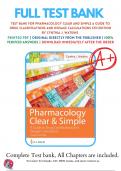Exam (elaborations)
Test bank for Pharmacology Clear and Simple 4th Edition by Watkins 9781719644747 | All Chapters with Answers and Rationals
- Course
- Institution
- Book
Title: Pharmacology Clear and Simple 4th Edition by Watkins Test Bank ISBN: 9781719644747 Number of Pages: 423 Edition: 4th Author: Watkins Number of Chapters: 21 Dive into Pharmacology Clear and Simple, 4th Edition by Watkins Test Bank—an invaluable resource for nursing students! Crafte...
[Show more]



